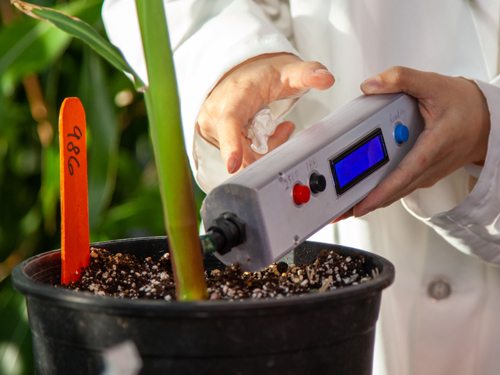EnGeniousAg’s easy-to-use nitrogen sensor can save farmers money — and help them better steward the land they depend on.
As an entrepreneurially minded plant scientist, Patrick Schnable got excited when he learned Liang Dong had developed a nitrogen sensor.
Dong, the Vikram L. Dalal Professor of Electrical and Computer Engineering, is a Plant Sciences Institute Scholar recruited to Iowa State by Schnable to do collaborative research that helps agriculture.
Nitrogen monitoring is a problem. Failing to use enough on a corn crop puts yields and profitability at risk. Use too much, and it wastes money and potentially harms the environment. Accurate nitrogen testing can be a challenge, though, because factors like soil makeup, weather, and crop genetics can interfere.
Identifying nitrogen need
Dong’s innovation addresses this problem and has led to founding EnGeniousAg LLC, the latest business launched by Schnable, who is the Iowa Corn Promotion Board Endowed Chair in Genetics and director of the Plant Sciences Institute. The business partnership includes Dong; Mike Castellano, the William T. Frankenberger Professor in Soil Science; and Schnable’s son James, an agronomist at the University of Nebraska.
“It can be hard to determine the appropriate amount of nitrogen to put on a field. Some fields need it, some don’t, and it changes from year to year,” says Schnable says.
In any given year, a significant percentage of fields don’t need nitrogen fertilizer, despite producing average or above-average yields. Identifying fields that won’t benefit from nitrogen fertilizer could save billions of dollars in inputs.
Most ‘Engenious’? It’s user-friendly
EnGeniousAg, based at the ISU Research Park, received a $1 million National Science Foundation Phase II Small Business Innovation Research grant. The grant funded extensive field testing, helping to refine the nitrogen sensor and ensure its user-friendliness.
The sensor is a hand-held device with two prongs that a farmer can take into the field and insert into a cornstalk to get a nitrogen level reading within seconds. This enables prompt and appropriate nitrogen application decisions, which contributes to profitability and reduces excess nitrogen entering the soil, air, and waterways.

—Patrick Schnable
Not only can the technology behind the innovative sensor filter out other materials that can skew a nitrogen reading, the sensor could also be used to detect nitrates in water, measuring the effectiveness of mitigation strategies such as nitrogen-capture in wetlands.
“This device is so cool because it benefits everyone,” Schnable says. “It validates our whole approach to developing new technologies that solve problems.”



